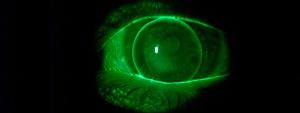Do you have keratoconus? Here are 8 frequently asked questions about contact lenses for keratoconus.
Q1: What is keratoconus?
Keratoconus (KC) is a progressive, non-inflammatory, corneal condition in which the cornea gradually becomes thinner until the corneal surface begins to bulge— resulting in astigmatism and blurred vision.
In its early stages, KC is generally treated with glasses or contact lenses to improve vision clarity.
As the condition progresses, specific contact lenses, including hard (RGP) or scleral lenses, are essential to compensate for the new irregular shape of the cornea and improve vision clarity.
Q2: Can I use soft contact lenses?
Soft toric contact lenses can be used to correct astigmatism, only in the early stages of KC.
However, since soft lenses mold to the shape of your cornea, as KC progresses, soft lenses will no longer be effective in providing clear vision.
Q3: How do custom soft contact lenses work?
Custom soft contacts are designed to match the exact contour of your cornea and are therefore highly effective in correcting astigmatism.
Custom soft lenses are also designed to sit correctly on the cornea, making them more stable on the eye and eliminating distorted vision from excessive movement.
However, as the lens is soft, even custom designed soft contact lenses are generally only successful in the early stages of KC.
Q4: Are hard contact lenses an option?
Hard contact lenses, also known as rigid gas permeable (RGP) lenses, are the most effective treatment for moderate KC.
RGP lenses are designed to create a new optical surface for effective light refraction— thereby correcting the astigmatism and providing clear vision.
These lenses also provide a higher oxygen permeability than standard soft lenses, making them a great choice to maintain eye health during contact lens wear.
Scleral lenses are a type of hard lens that offers major benefits for KC patients, as the lens vaults over the cornea by-passing the corneal problems of this condition.
SEE RELATED: Keratoconus
Contact an eye doctor near you if you notice any changes in your vision.
Q5: What are hybrid lenses?
Hybrid lenses are a combination of both hard and soft lenses.
The hard center of these lenses provides a flat surface to compensate for the bulging cornea, while the soft outer ring makes these lenses more comfortable.
Hybrid lenses offer the comfort of soft lenses with the crisp, clear vision of hard lenses.
Q6: What is the advantage of scleral lenses?
Scleral lenses are larger than all other types of contact lenses.
Their larger size allows them to vault over the cornea and rest on the sclera, the white part of the eye, avoiding contact with the sensitive, bulging cornea and reducing the risk of corneal injury.
Their larger size also makes them more comfortable and stable than RGP lenses.
Moreover, scleral lenses contain a reservoir of saline solution that sits between the scleral lens and the surface of the cornea to maintain moisture and hydration throughout the day, and allow for increased oxygen permeability.
Scleral contact lenses are a highly successful treatment option for KC, high astigmatism and other corneal conditions.
Q7: How many hours per day can scleral lenses be worn?
Many people wear their scleral lenses for 12-14 hours per day without any discomfort.
However, to achieve the clearest vision and enjoy optimal comfort, it is recommended to remove your scleral lenses several times per day in order to clean them and reapply fresh saline.
LEARN MORE: Guide to Corneal Conditions
Contact an eye doctor near you if you notice any changes in your vision.
If you have keratoconus, your optometrist will discuss the different types of treatment options with you.
Treatment for keratoconus is tailored to each patient based on the severity and progression of the condition, as well as the patient’s lifestyle.


